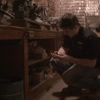
The Importance of Being (an) Earnest (Gaffer)
Written by Kristen Paulson | Posted by: Anonymous
Gaffers! Camera! Action!
Perhaps you believed, erroneously, that a gaffer was an elderly man. To enlighten you, a gaffer is the head of a film production’s electrical department. A gaffer’s role varies depending on the size of a production and its individuals. For example, if a film has a large budget, a gaffer oversees the light supply, and a grip modifies it.
Guy Holt, President of ScreenLight & Grip, stresses that "Any production is a collaboration. Roles and responsibilities depend on personal relationships built with co-collaborators." In fact, the cameraperson and the gaffer work together closely to ensure needs are met. "Some camerapeople don’t get involved with lighting, and use a gaffer to create with it, while others have a knack for lighting," explains Guy. In his opinion, a best-case collaboration is represented by cameraman David Quaid. Whenever Quaid was stumped, he relied on his crew, down to the "lowliest PA" to help problem-solve.
In film production, three departments comprise the basic crew. Since they’re so closely linked, I’ll touch briefly on the other two crew departments besides electrical, under which the position of gaffer falls: cameraperson and grip.
Cameraperson
The cameraperson is the head of the crew—all things flow from him or her, and he or she oversees the camera and its function. Gaffing is a traditional career path to this position. The cameraperson’s job is also the most glamorous: they get to travel. The hierarchy is structured thusly: Start as a loader, loading film magazines. Work your way from First Assistant cameraperson (AC), to Second AC, arriving triumphantly at Cameraperson.
(Get a) Grip
The grip provides camera movement, support, and safety, modifies light and camera movement, and deals with engineering issues such as stress and load capacity. As Guy describes it, a grip is ideally "A grown-up kid with an Erector Set."
As such, the position requires an engineering mentality. One of the best grips Guy knew was a tree surgeon in the off-season–extremely fitting since a grip deals with lumber, climbing, and sawing things. He builds rigging and can’t be afraid of heights since he often "flies" (places) cameras in difficult areas such as the sides of buildings.
Electrical–"Let There Be Light."
The electrical department supplies light and manages its exposure. A gaffer heads up this department as an electrical specialist who deals with electrical distribution, the physics of lighting, and the lighting instruments. They are also responsible for controlling the lighting contrast (range of exposure values from light to dark) so it can be rendered on film.
The position takes an understanding of photographic principles, film, and the cameraperson’s job. A gaffer must be able to anticipate their needs, filling-in if necessary. While the cameraperson is filming, the gaffer lights the next setup.
Equal parts interpreter, photographer and artiste, a gaffer translates how film will be rendered. Is the mood jarring? Dark? Ideally he or she can work with the cameraperson to settle on a specific lighting design, and then provide technical support, implementing their vision.
To illustrate a gaffer’s importance, think of the film "SE7EN." It was difficult to achieve that "dark all the time" look. A gaffer should know — it’s their responsibility. To illustrate, while filming say, a feature film, one encounters dramatic changes in the prevailing light, since five minutes of screen time may represent several days of filming. The gaffer must recreate, or re-render, if you will, the original effect, being sure to maintain consistency.
I Did It MY WAY! Or, How You Can Be a Gaffer
One way to get on the road to gaffdom is to attend a film program. There are many in the Boston area to speed you on your way. Contact the Boston Film/Video Foundation (BFVF) at or try the International Film & Television Workshops in Maine. See a list of programs in the NewEnglandFilm.com industry directory under "Educational Programs."
In addition, many area colleges offer film degrees, such as Emerson College, and Boston University. This approach gives an overview of being a filmmaker.
Your second "in" as a gaffer is to sign up as a production assistant and work your way up the crew ladder. Check with NewEnglandFilm.com jobs page or the Massachusetts Film Office for production job listings. You can also call their hotline (617- 973-8800, press 1), which is updated when film companies come to town. As a PA on a set, you’ll learn about the equipment and how it’s used. You can then move up to specialize as a camera or an electrical grip. Choose the electrical department, and be all you can be. Be a gaffer.
Don’t Wait, Learn Now!
Finally, it’s difficult to say you’re a gaffer ("Poof, you’re a gaffer!"). It takes years of experience and knowledge. But hopefully you’ve learned enough to light your way in the previous dark night of ignorance with the torch you now possess.
See the NewEnglandFilm.com industry directory for listings of 'gaffers' in the community. Guy Holt has been a local gaffer for ten of the 20 years he’s worked in the film industry. He puts visiting producers and cameramen in touch with local resources, partially through his Web site, at: http://www.screenlightandgrip.com/.











